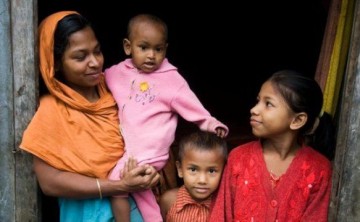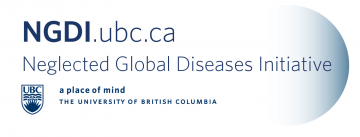Dr. Charles Larson, NGDI Associate, heads “Interrupting Pathways to Maternal, Newborn and Early Childhood Sepsis Initiative” in Bangladesh
Country: Bangladesh
Project duration and funding amount: 2011-2014; $2,795,738
UBC’s full press release is available here.
The objective of this project is to improve the survival rate of more than 53,000 beneficiaries, including mothers, newborns and children under the age of five, through the prevention of sepsis, a life-threatening form of infection in which the bloodstream is overwhelmed by bacteria. Sixty midwives and birth attendants, 45 nurses and doctors, 100 primary health care providers and 12 paramedics will be trained to detect, refer and treat sepsis.
Early detection and interruption of pathways to sepsis among newborns and young children in least developed countries has been a largely neglected and misunderstood issue. While not a disease per se, sepsis is the final common pathway for many childhood infectious illnesses such as pneumonia, diarrhea, malaria, HIV, etc. as children progress from an acute to a severe infectious episode leading to sepsis and eventually death. Of the nearly 8 million under-five children who die each year, it is estimated that 50 to 70% of these deaths will be the result of children entering this pathway.
 Among those that survive, the majority will have compromised immune responses thus impairing their capacity to deal with repeat infection. As a consequence, as many children will die following recovery and discharge from a clinic or hospital as die during admission. Particularly among neonates, sepsis threatens to derail the progress Bangladesh (and other developing countries) is making in reducing child mortality. Efforts to prevent sepsis in Bangladesh and improve access to good quality care in public sector health facilities are essential.
Among those that survive, the majority will have compromised immune responses thus impairing their capacity to deal with repeat infection. As a consequence, as many children will die following recovery and discharge from a clinic or hospital as die during admission. Particularly among neonates, sepsis threatens to derail the progress Bangladesh (and other developing countries) is making in reducing child mortality. Efforts to prevent sepsis in Bangladesh and improve access to good quality care in public sector health facilities are essential.
The Government of Bangladesh has developed a National Neonatal Health Strategy (NNHS) and Action Plan and adopted Community-Based Case Management of Childhood Illnesses as priority strategies. Both emphasize the need for health service providers at all levels to be skilled in identifying and managing sepsis. The strategy specifically calls for the conduct of demonstration projects towards scaling up management of innovative sepsis responses.
 In partnership with the Bangladesh Ministry of Health and Family Welfare (MOHFW), ICDDR,B and faculty from UBC and McGill, this project will establish demonstration sites in two (perhaps three) Bangladesh sub-districts in which integrated innovations will be implemented and evaluated that involve the coordinated actions of communities, midwives, primary care providers, mHealth communication and diagnostic support, aggressive early treatment with antimicrobials and fluids, strengthened referral and transport systems, and zinc supplementation of syndromic sepsis survivors.
In partnership with the Bangladesh Ministry of Health and Family Welfare (MOHFW), ICDDR,B and faculty from UBC and McGill, this project will establish demonstration sites in two (perhaps three) Bangladesh sub-districts in which integrated innovations will be implemented and evaluated that involve the coordinated actions of communities, midwives, primary care providers, mHealth communication and diagnostic support, aggressive early treatment with antimicrobials and fluids, strengthened referral and transport systems, and zinc supplementation of syndromic sepsis survivors.
The ultimate objective is to improve maternal and child survival in Bangladesh through the prevention and interruption of pathways to sepsis. Specific objectives include;
1. Community engagement through strengthened community awareness and readiness to participate in sepsis early intervention and prevention activities.
2. Establish demonstration sites that foster the complementary participation of households, communities, primary care and district hospital facilities. Within these sites we will implement and closely monitor intervention packages that provide a combination of the following:
a. Attended deliveries by midwives or skilled attendants trained in sepsis identification, early intervention and referral.
b. Integrated Community Case Management (ICCM) and Integrated Management of Childhood Illnesses (IMCI)compatible guideline modifications.
c. Modified clinical practice guidelines to be implemented in sub-district or district hospitals during and following a syndromic sepsis episode.
d. Cell phone/(mobile) mHealth adaptations to:
i. Enhance communication between villages, primary care centres and district hospitals
ii. Obtain vital clinical information to guide treatment or referral decision making
e. Strengthened referral and transport capabilities; working in conjunction with cell phone adaptations
i. Development and refinement of motorized and/or non-motorized ambulance infrastructures. Trailer options for long distance and burdensome terrain conveyance will also be introduced.
ii. Ambulance pools staffed by trained paramedics.
3. Monitor the impact of the project’s intervention packages in terms of disease burden and practices as they are integrated into communities and existing health systems.
4. Conduct a public health policy analysis of the intervention packages.
UBC Investigators:
- Charles Larson, Centre for International Child Health, Department of Pediatrics, School of Population and Public Health
- Niranjan Kissoon, Centre for International Child Health, Department of Pediatrics
- Mark Ansermino, Centre for International Child Health, Department of Anesthesia
- Kishor Wasan, Neglected Global Diseases Initiative, Faculty of Pharmaceutical Sciences
- Guy Dumont, Faculty of Engineering
- Cathy Ellis, Family Practice, Division of Midwifery
- Rosemin Kassam, School of Population and Public Health
- Alex Berland, School of Population and Public Health

- International Centre for Diarrheal Disease Research, Bangladesh (ICDDR,B)
- Government of Bangladesh, Ministry of health and Family Welfare
- School of Nursing, International University of Business, Agriculture and Technology, Bangladesh
- Simon Fraser University
- McGill University


